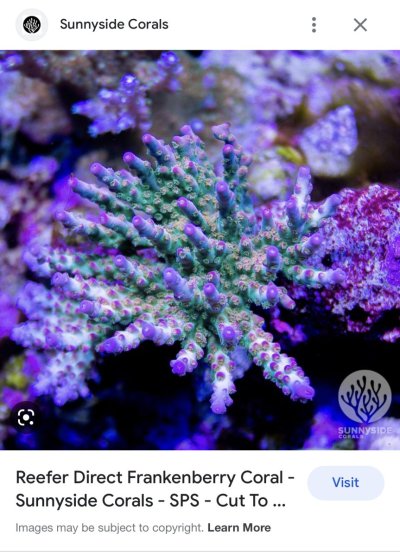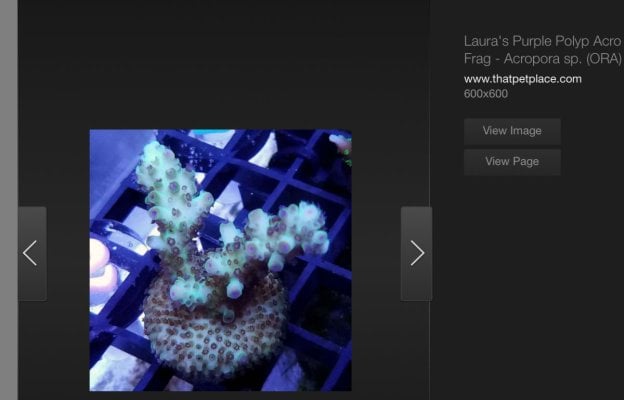Navigation
Install the app
How to install the app on iOS
Follow along with the video below to see how to install our site as a web app on your home screen.

Note: This feature currently requires accessing the site using the built-in Safari browser.
More options
You are using an out of date browser. It may not display this or other websites correctly.
You should upgrade or use an alternative browser.
You should upgrade or use an alternative browser.
Acropora ID (species)
- Thread starter mdb_talon
- Start date
Almost has granulosa-like tips. But this is what it immediately reminds me of this stock photo of BC Flamethrower Love. Could be a granulosa but not confident in that guess.

Graffiti Spot
Cat and coral maker
- Review score
- +0 /0 /-0
R2R Supporter
R2R Excellence Award
- Joined
- Oct 8, 2012
- Messages
- 4,288
- Reaction score
- 3,632
- Review score
- +0 /0 /-0
- Location
- Florida’s west side
Looks more like acropora appressa to me. I don’t see grannies with so many coralites and so much basing out but the axials are fairly smooth which is normal with appressa.
I think that’s a great point. The question I have with appressa is that it’s mainly a western Indian Ocean/Eastern African coastline coral with a small area of prevalence represented in Indonesia/Malaysia (which I’d bet is a separate species).Looks more like acropora appressa to me. I don’t see grannies with so many coralites and so much basing out but the axials are fairly smooth which is normal with appressa.
I think when the DNA studies are actually done, we’re going to have 5x as many acroporids as are currently recognized.
Graffiti Spot
Cat and coral maker
- Review score
- +0 /0 /-0
R2R Supporter
R2R Excellence Award
- Joined
- Oct 8, 2012
- Messages
- 4,288
- Reaction score
- 3,632
- Review score
- +0 /0 /-0
- Location
- Florida’s west side
I think that’s a great point. The question I have with appressa is that it’s mainly a western Indian Ocean/Eastern African coastline coral with a small area of prevalence represented in Indonesia/Malaysia (which I’d bet is a separate species).
I think when the DNA studies are actually done, we’re going to have 5x as many acroporids as are currently recognized.
Yea it certainly looks like an indo cultures base that it’s sitting on. I had one almost just like it that I was confused about the id with and I had got it in a box from Bali. I would love to see more effort/support go into research for acropora species in a number of ways, better ID being one of them for sure.
This pic looks like apache chief. Wonder if it's the same, just different vendor.Looks like my Frankenberry
Demos Apache Chief
An example of "showing your age" with some true beauty. Apache Chief acropora holds a robust neon green in the mature tissue, heavenly pearl white in the middle, and a royal purple on the tips. Apache Chief is hardy yet stunning and one of our staple acro strains here at Capital Coral. a great...
 www.capitalcoral.com
www.capitalcoral.com
Graffiti Spot
Cat and coral maker
- Review score
- +0 /0 /-0
R2R Supporter
R2R Excellence Award
- Joined
- Oct 8, 2012
- Messages
- 4,288
- Reaction score
- 3,632
- Review score
- +0 /0 /-0
- Location
- Florida’s west side
Frankenberry is something along the lines of acropora plana.
Apache chief looks like austera/tort
Apache chief looks like austera/tort
- Joined
- Aug 24, 2020
- Messages
- 1,204
- Reaction score
- 946
- Review score
- +0 /0 /-0
- Location
- Washington State
I would not recommend identifying aquarium corals down to the species, as corals that have been in captivity for a long time may look very different than their wild counterparts.
I think this becomes more of a philosophical argument than a scientific one as there is currently no valid classification system/taxonomy for either wild or captive Acropora species barring either massive DNA work or attempts to sexually breed corals via crosses. And the latter may not be a valid means of assessing species given that Craggs et al. have successfully crossed different species with resultant viable offspring.I would not recommend identifying aquarium corals down to the species, as corals that have been in captivity for a long time may look very different than their wild counterparts.
So given the ongoing disaster that is current Acropora taxonomy with who knows how many occult species, I feel like defaulting to morphologic assessment is no great evil.
Morphological analysis is definitely the best we can do given the lack of DNA proof behind species assignments, and as you pointed out, many of the species may not even be fully isolated from each other and just present different phenotypes but still be able to breed. This compounded with the fact that many aquarium acropora specimens are either too small to see full colony shape or flow/fragging patterns prevent the colony from taking its shape, it's usually a difficult question when someone asks on the forum to identify an acropora species.I think this becomes more of a philosophical argument than a scientific one as there is currently no valid classification system/taxonomy for either wild or captive Acropora species barring either massive DNA work or attempts to sexually breed corals via crosses. And the latter may not be a valid means of assessing species given that Craggs et al. have successfully crossed different species with resultant viable offspring.
So given the ongoing disaster that is current Acropora taxonomy with who knows how many occult species, I feel like defaulting to morphologic assessment is no great evil.
Last edited:
I freakin love these threads where we actually try to identify species with available information rather than going off looney tunes names.
I freakin love these threads where we actually try to identify species with available information rather than going off looney tunes names.
Lol me too. I do appreciate everyone's input greatly. Whether we can be 100% sure or not is less relevant to me than getting some input and the suggestions made have helped me research myself and while I may never know for certain I know more now than I did before posting.


















